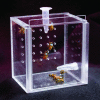Stimulation of muscarinic receptors mimics experience-dependent plasticity in the honey bee brain
- PMID: 16373504
- PMCID: PMC1324993
- DOI: 10.1073/pnas.0508318102
Stimulation of muscarinic receptors mimics experience-dependent plasticity in the honey bee brain
Abstract
Honey bees begin life working in the hive. At approximately 3 weeks of age, they shift to visiting flowers to forage for pollen and nectar. Foraging is a complex task associated with enlargement of the mushroom bodies, a brain region important in insects for certain forms of learning and memory. We report here that foraging bees had a larger volume of mushroom body neuropil than did age-matched bees confined to the hive. This result indicates that direct experience of the world outside the hive causes mushroom body neuropil growth in bees. We also show that oral treatment of caged bees with pilocarpine, a muscarinic agonist, induced an increase in the volume of the neuropil similar to that seen after a week of foraging experience. Effects of pilocarpine were blocked by scopolamine, a muscarinic antagonist. Our results suggest that signaling in cholinergic pathways couples experience to structural brain plasticity.
Figures



Similar articles
-
Effects of experience and juvenile hormone on the organization of the mushroom bodies of honey bees.J Neurobiol. 1995 Jan;26(1):130-44. doi: 10.1002/neu.480260111. J Neurobiol. 1995. PMID: 7714522
-
Muscarinic regulation of Kenyon cell dendritic arborizations in adult worker honey bees.Arthropod Struct Dev. 2011 Sep;40(5):409-19. doi: 10.1016/j.asd.2011.01.003. Epub 2011 Jan 22. Arthropod Struct Dev. 2011. PMID: 21262388 Free PMC article.
-
Experience-dependent plasticity in the mushroom bodies of the solitary bee Osmia lignaria (Megachilidae).Dev Neurobiol. 2008 Jan;68(1):73-82. doi: 10.1002/dneu.20574. Dev Neurobiol. 2008. PMID: 17918235
-
Gamma-aminobutyric acid in the honey bee mushroom bodies - is inhibition the wellspring of plasticity?Curr Opin Insect Sci. 2024 Dec;66:101278. doi: 10.1016/j.cois.2024.101278. Epub 2024 Oct 5. Curr Opin Insect Sci. 2024. PMID: 39369905 Review.
-
Food for thought: honeybee foraging, memory, and acetylcholine.Sci STKE. 2006 May 23;2006(336):pe23. doi: 10.1126/stke.3362006pe23. Sci STKE. 2006. PMID: 16720841 Review.
Cited by
-
Differentiation of workers into soldiers is associated with a size reduction of higher-order brain centers in the neotropical termite Procornitermes araujoi.Sci Rep. 2023 Oct 25;13(1):18279. doi: 10.1038/s41598-023-45221-0. Sci Rep. 2023. PMID: 37880273 Free PMC article.
-
Mblk-1 Transcription Factor Family: Its Roles in Various Animals and Regulation by NOL4 Splice Variants in Mammals.Int J Mol Sci. 2017 Jan 25;18(2):246. doi: 10.3390/ijms18020246. Int J Mol Sci. 2017. PMID: 28125049 Free PMC article. Review.
-
Pilocarpine improves recognition of nestmates in young honey bees.Neurosci Lett. 2008 Jul 11;439(2):178-81. doi: 10.1016/j.neulet.2008.05.014. Epub 2008 May 10. Neurosci Lett. 2008. PMID: 18514413 Free PMC article.
-
Rho GTPase activity in the honey bee mushroom bodies is correlated with age and foraging experience.J Insect Physiol. 2012 Feb;58(2):228-34. doi: 10.1016/j.jinsphys.2011.11.009. Epub 2011 Nov 15. J Insect Physiol. 2012. PMID: 22108023 Free PMC article.
-
Laboratory Assay of Brood Care for Quantitative Analyses of Individual Differences in Honey Bee (Apis mellifera) Affiliative Behavior.PLoS One. 2015 Nov 16;10(11):e0143183. doi: 10.1371/journal.pone.0143183. eCollection 2015. PLoS One. 2015. PMID: 26569402 Free PMC article.
References
-
- Greenough, W. T. & Volkmar, F. R. (1973) Exp. Neurol. 40, 491–504. - PubMed
-
- Seeley, T. D. (1982) Behav. Ecol. Sociobiol. 11, 287–293.
-
- Neukirch, A. (1982) J. Comp. Physiol. B 146, 35–40.
-
- Menzel, R. (1985) in Experimental Behavioral Ecology and Sociobiology, eds. Hölldobler, B. & Lindauer, M. (Fischer, New York).
Publication types
MeSH terms
Substances
LinkOut - more resources
Full Text Sources
Other Literature Sources

